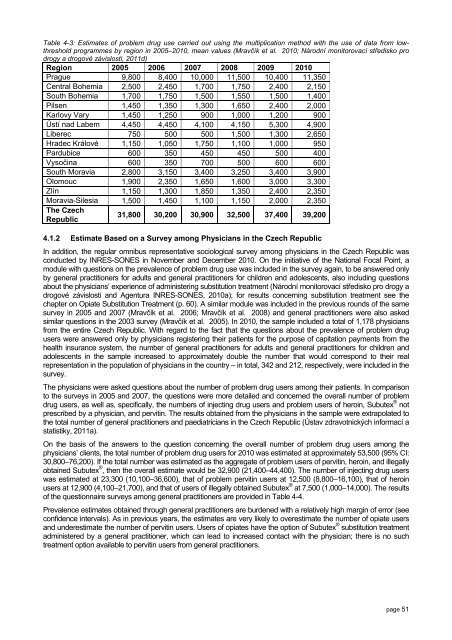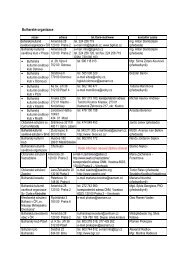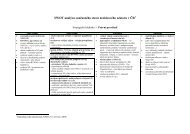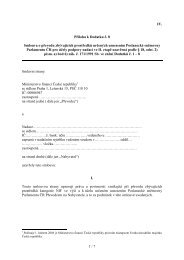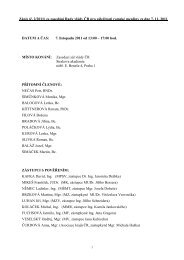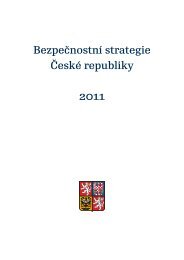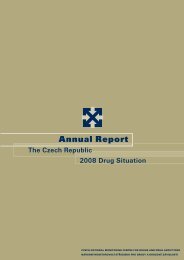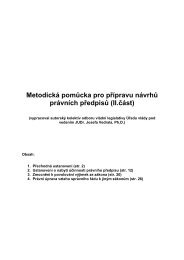The Czech Republic Annual Report 2010 Drug ... - Drogy-info.cz
The Czech Republic Annual Report 2010 Drug ... - Drogy-info.cz
The Czech Republic Annual Report 2010 Drug ... - Drogy-info.cz
You also want an ePaper? Increase the reach of your titles
YUMPU automatically turns print PDFs into web optimized ePapers that Google loves.
Table 4-3: Estimates of problem drug use carried out using the multiplication method with the use of data from lowthreshold<br />
programmes by region in 2005–<strong>2010</strong>, mean values (Mravčík et al. <strong>2010</strong>; Národní monitorovací středisko pro<br />
drogy a drogové závislosti, 2011d)<br />
Region 2005 2006 2007 2008 2009 <strong>2010</strong><br />
Prague 9,800 8,400 10,000 11,500 10,400 11,350<br />
Central Bohemia 2,500 2,450 1,700 1,750 2,400 2,150<br />
South Bohemia 1,700 1,750 1,500 1,550 1,500 1,400<br />
Pilsen 1,450 1,350 1,300 1,650 2,400 2,000<br />
Karlovy Vary 1,450 1,250 900 1,000 1,200 900<br />
Ústí nad Labem 4,450 4,450 4,100 4,150 5,300 4,900<br />
Liberec 750 500 500 1,500 1,300 2,650<br />
Hradec Králové 1,150 1,050 1,750 1,100 1,000 950<br />
Pardubice 600 350 450 450 500 400<br />
Vysočina 600 350 700 500 600 600<br />
South Moravia 2,800 3,150 3,400 3,250 3,400 3,900<br />
Olomouc 1,900 2,350 1,650 1,600 3,000 3,300<br />
Zlín 1,150 1,300 1,850 1,350 2,400 2,350<br />
Moravia-Silesia 1,500 1,450 1,100 1,150 2,000 2,350<br />
<strong>The</strong> <strong>Czech</strong><br />
<strong>Republic</strong><br />
31,800 30,200 30,900 32,500 37,400 39,200<br />
4.1.2 Estimate Based on a Survey among Physicians in the <strong>Czech</strong> <strong>Republic</strong><br />
In addition, the regular omnibus representative sociological survey among physicians in the <strong>Czech</strong> <strong>Republic</strong> was<br />
conducted by INRES-SONES in November and December <strong>2010</strong>. On the initiative of the National Focal Point, a<br />
module with questions on the prevalence of problem drug use was included in the survey again, to be answered only<br />
by general practitioners for adults and general practitioners for children and adolescents, also including questions<br />
about the physicians’ experience of administering substitution treatment (Národní monitorovací středisko pro drogy a<br />
drogové závislosti and Agentura INRES-SONES, <strong>2010</strong>a); for results concerning substitution treatment see the<br />
chapter on Opiate Substitution Treatment (p. 60). A similar module was included in the previous rounds of the same<br />
survey in 2005 and 2007 (Mravčík et al. 2006; Mravčík et al. 2008) and general practitioners were also asked<br />
similar questions in the 2003 survey (Mravčík et al. 2005). In <strong>2010</strong>, the sample included a total of 1,178 physicians<br />
from the entire <strong>Czech</strong> <strong>Republic</strong>. With regard to the fact that the questions about the prevalence of problem drug<br />
users were answered only by physicians registering their patients for the purpose of capitation payments from the<br />
health insurance system, the number of general practitioners for adults and general practitioners for children and<br />
adolescents in the sample increased to approximately double the number that would correspond to their real<br />
representation in the population of physicians in the country – in total, 342 and 212, respectively, were included in the<br />
survey.<br />
<strong>The</strong> physicians were asked questions about the number of problem drug users among their patients. In comparison<br />
to the surveys in 2005 and 2007, the questions were more detailed and concerned the overall number of problem<br />
drug users, as well as, specifically, the numbers of injecting drug users and problem users of heroin, Subutex ® not<br />
prescribed by a physician, and pervitin. <strong>The</strong> results obtained from the physicians in the sample were extrapolated to<br />
the total number of general practitioners and paediatricians in the <strong>Czech</strong> <strong>Republic</strong> (Ústav zdravotnických <strong>info</strong>rmací a<br />
statistiky, 2011a).<br />
On the basis of the answers to the question concerning the overall number of problem drug users among the<br />
physicians’ clients, the total number of problem drug users for <strong>2010</strong> was estimated at approximately 53,500 (95% CI:<br />
30,800–76,200). If the total number was estimated as the aggregate of problem users of pervitin, heroin, and illegally<br />
obtained Subutex ® , then the overall estimate would be 32,900 (21,400–44,400). <strong>The</strong> number of injecting drug users<br />
was estimated at 23,300 (10,100–36,600), that of problem pervitin users at 12,500 (8,800–16,100), that of heroin<br />
users at 12,900 (4,100–21,700), and that of users of illegally obtained Subutex ® at 7,500 (1,000–14,000). <strong>The</strong> results<br />
of the questionnaire surveys among general practitioners are provided in Table 4-4.<br />
Prevalence estimates obtained through general practitioners are burdened with a relatively high margin of error (see<br />
confidence intervals). As in previous years, the estimates are very likely to overestimate the number of opiate users<br />
and underestimate the number of pervitin users. Users of opiates have the option of Subutex ® substitution treatment<br />
administered by a general practitioner, which can lead to increased contact with the physician; there is no such<br />
treatment option available to pervitin users from general practitioners.<br />
page 51


